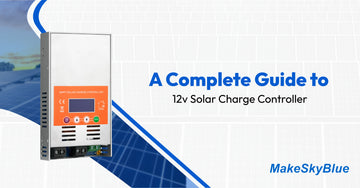A 12v solar charge controller is a necessary component of any solar system. It safeguards the battery and efficient charge. In its absence, the battery can either overcharge or discharge. Both conditions reduce battery life and lower solar system efficiency. This guide explains what a charge controller does, how it works, and which type suits your needs. You will also learn about mppt and pwm models, different sizes like 10a, 30a, and 60a, and features such as app control or monitoring.
What is a Charge Controller?
A charge controller is a device placed between a solar panel and a battery. Its role is to manage the flow of energy. The device prevents overcharging and deep discharge. It also ensures a stable power output for your system.
-
Regulates charge from solar panel
-
Protects the battery voltage
-
Maintains correct current flow
-
Improves solar efficiency
The majority of controllers are compatible with lead-acid batteries, lithium, AGM, gel and lifepo4. The selection of the model to use is determined by the battery and size of solar panel.
Why a Solar Charge Controller is Important
Every solar charge controller works as a safeguard. Solar panels generate fluctuating voltage. Without a regulator, batteries may get damaged. Its key benefits include that it normally prevents battery overcharge and controls power output. Moreover, it extends battery bank life and improves off-grid systems efficiency. This makes the controller a vital part of every solar power system.
Types of Solar Controllers
There are mainly two types of solar controllers. Both serve the same purpose but work differently.
PWM Solar Charge Controller
A pwm solar charge controller is simple and affordable. It is suitable for small systems like RVs, boats, and basic off-grid setups. It normally works with 12v as well as 24v batteries and maintains constant voltage regulation. In addition it is efficient for low power output.
MPPT Solar Charge Controller
An mppt solar charge controller is more advanced. It tracks the maximum power from solar panels and converts it into usable energy. It provides a higher efficiency rate and works with 12v, 24v, 36v, and 48v systems. Furthermore it is best for larger solar power setups
Features of Modern Solar Controllers
Modern solar controllers are not limited to just charging. They include smart technology for better monitoring.
-
Bluetooth and app control for remote monitoring
-
Cut-off protection to prevent overcharge
-
Waterproof designs for outdoor setups
-
Compatible with lithium, AGM, gel, and lead-acid batteries
-
Different amp ratings such as 10a, 20a, 30a, 40a, 60a, 80a, and 100a
These features make them flexible for different solar systems.
Comparison of PWM vs MPPT Solar Charge Controllers
|
Feature |
PWM Solar Charge Controller |
MPPT Solar Charge Controller |
|
Efficiency Rate |
70–80% |
95–99% |
|
Best For |
Small systems (RVs, boats) |
Large systems, off-grid |
|
Voltage Support |
12v, 24v |
12v, 24v, 36v, 48v |
|
Cost |
Affordable |
Higher |
|
Monitoring Options |
Basic |
Advanced (Bluetooth, app) |
|
Solar Panel Compatibility |
Small panels |
Large PV panels |
Solar Charge Controllers for Sale
There are many controllers for sale in the market. Brands like Victron, Renogy, and Litime offer both pwm and mppt models. Some are designed for marine and RV use, while others are built for heavy off-grid systems. When buying it is good to check if it supports your battery type (AGM, lithium, lifepo4) and ensure waterproof if used outdoors. In addition, select app control for easy monitoring and match voltage with your solar panel setup (12v, 24v, 36v, or 48v)
Popular Solar Charge Controller Options
|
Model / Brand |
Type |
Voltage Support |
Amp Rating |
Special Feature |
|
Victron SmartSolar |
MPPT |
12v–48v |
30a–100a |
Bluetooth app control |
|
Renogy Rover |
MPPT |
12v / 24v |
20a–60a |
LCD + waterproof |
|
Litime PWM |
PWM |
12v / 24v |
10a–30a |
Budget-friendly |
|
EPEVER Tracer |
MPPT |
12v–48v |
10a–80a |
High efficiency rate |
|
Allpowers Controller |
PWM |
12v / 24v |
20a–40a |
Easy RV setup |
Installation of a 12v Solar Charge Controller
Installing a 12v solar charge controller is straightforward.
-
Connect the controller to the battery first.
-
Then connect the solar panel to the controller.
-
If required, connect the load output.
-
Check the LCD or app for monitoring.
Always follow manufacturer guidelines. Wrong installation may cause damage to your battery bank or solar panel.
Conclusion
Every solar energy system requires a 12v solar charge controller. It enables the battery to be safe, enhances efficiency of the system, and makes performance prolonged. No matter if you want a pwm controller to run smaller applications or an mppt controller with high output, the choices are normally based on your requirements.
Amp rating, compatibility with battery type, voltage support, and monitoring features are some of the most important factors to consider when purchasing. An intelligent decision will mean that your solar panel charger controller will be effective and will provide you with stable solar energy.
FAQs
What is a 12v solar charge controller?
It is a device that regulates voltage and current from solar panels. It protects batteries from overcharge and deep discharge.
Which is better, PWM or MPPT solar charge controller?
PWM is cost-effective for small systems. MPPT offers higher efficiency for large solar setups.
Can I use a 12v solar charge controller with lithium batteries?
Yes, many modern controllers are compatible with lithium, AGM, and lifepo4. Always check model specifications.
How do I size a solar charge controller?
Choose one with at least 25% more amp rating than your solar panel output. This ensures safe and efficient charging.
Do solar charge controllers support remote monitoring?
Yes, many MPPT and PWM models come with Bluetooth or app control. This makes monitoring solar power easy.





